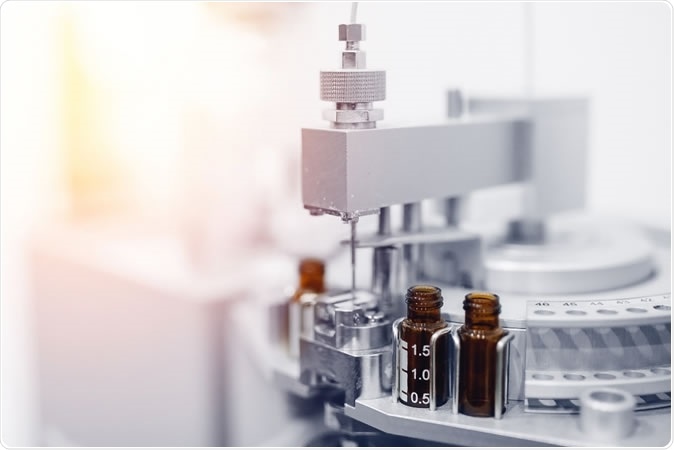There are many and various receptors on the surface of each human cell, which bind to specific molecules called ligands, to set off signals that modulate cell activity accordingly. These pathways are exploited by therapeutic drugs. In fact, one in three drugs makes use of receptors belonging to a single very large family – the GPCR (G protein receptor coupled receptor) family.

Image Credit: Parilov / Shutterstock
Signaling systems
The human organism is made up of a vast diversity of cell types and tissues. For this reason, it is necessary to coordinate body processes by precise and versatile signaling systems. These are typically made up of a receptor site, to which one or more ligands bind, to trigger a cellular signal. This can be used to manipulate cellular processes by designing or discovering ligand-mimicking molecules, such as therapeutic drug molecules, to trigger or suppress specific cell activities as desired.
Prior to this study, scientists knew of 348 interactions between GPCRs and peptide ligands – 120 receptors and 185 peptides. Yet, we still don’t know which ligands are involved for about a hundred GPCR systems – almost a third of these receptors.
The study
In the current study, the researchers aimed to find signaling peptides. More than 70% of all known ligands for GPCRs are peptides, so this looked like a productive goal. Moreover, more than half of the protein targets for more than 85 peptide or protein drugs are GPCRs.
The scientists adopted a multidisciplinary approach to their search. They first analyzed the proteome of a human cell – the complete set of proteins produced by one cell. From this vast array of about 20 000 proteins, they picked out peptides which looked likely to be ligands. They especially targeted cell-secreted proteins, as any ligand would need to be produced and released from a cell.
Using bioinformatics, they recognized potential peptide ligands by their characteristic N-terminal signal peptide (needed for secretion of the peptide from a cell). They also found specific cleavage sites. This narrowed down their range of search.
From the secreted-protein list, they then zoomed in on only those with unknown functions.
To assist them in their search, they turned to machine learning algorithms, which could help predict the potential ligand role of a given peptide. To teach the machine what receptor and ligand genes could look like, they included whole genomes from over 300 species. This helped the program to learn how far these GPCR genes and peptides resembled functional GPCR and ligand proteins in any of the other species.
They arrived at a set of 218 ligands which had the potential to bind GPCRs, and 21 probable GPCRs without known ligands. Now they screened them against each other, using three extremely sophisticated and different techniques to detect any of three possible responses: the dynamic mass redistribution assay which measures how the cell mass changes following ligand binding, which captures the effects of multiple signaling pathways; whether the receptors moved into the cell (a process called internalization, dependent on ligand binding), and the appearance of a protein called beta-arrestin. This three-pronged approach was meant to maximize the chances of detection of ligand binding and resulting signal production via as many pathways as possible.
This blend of pharmacology, machine learning, genomics, and computational drug design took over 3 years of patient work, where they searched almost 21,500 different peptide-receptor interactions to detect actual pairs. Finally, the researchers found, to their amazement, that they had identified binding patterns for 5 GPCRs and 17 ligands. These GPCR genes are known to be involved in nerve illnesses, cancers and genetic diseases.
Pairing Orphan Peptides and Receptors/ Cell, October 31, 2019
Implications
Knowing the peptides that stimulate these receptors to produce cell signals, and the fact that these peptides are possibly responsible for many disease conditions, means they can turn the study to good account by helping to develop drugs which mimic these peptides but do not turn on the abnormal disease pathways. In addition, the researchers want to continue to find out how each of these multiple receptor-ligand interactions actually works in the human body.
Researcher David E. Gloriam says, “We have used a truly collaborative method in order to identify these new aspects of human biology. We would not have been able to identify this many pairs had it not been for the interdisciplinary nature of our method.”
Source:
Journal reference:
Discovery of human signaling systems:pairing peptides to G protein-coupled receptors. Simon R. Foster,Alexander S. Hauser, Line Vedel, Ryan T. Strachan, Xi-Ping Huang, Ariana C. Gavin, Sushrut D. Shah, Ajay P. Nayak, Linda M. Haugaard-Kedstro ̈m, Raymond B. Penn, Bryan L. Roth, Hans Bra ̈uner-Osborne, and David E. Gloriam. Cell. Cell179, 895–908October 31, 2019. https://www.cell.com/cell/fulltext/S0092-8674(19)31126-2